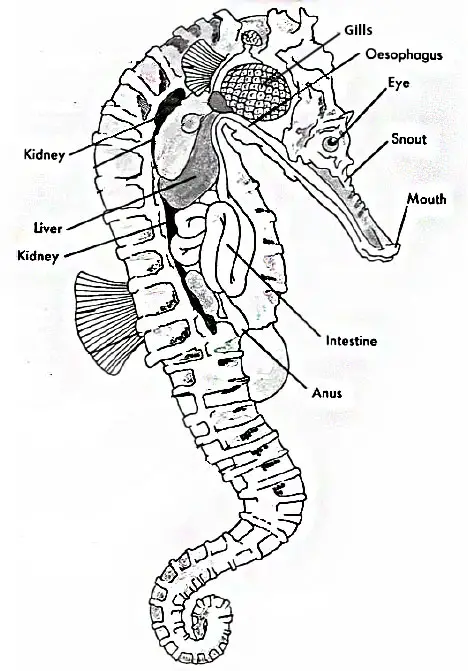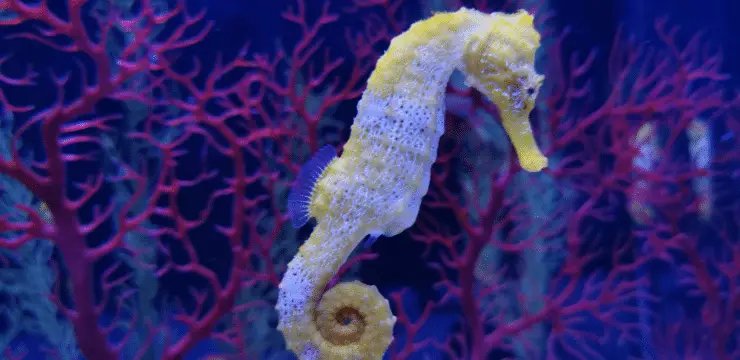Anatomically, like many aquatic creatures (Sharks, tuna fish), seahorses don’t have lungs. They are said to have “tufted” gills, special organs full of blood vessels. Gills help seahorses with oxygen intake and carbon-di-oxide excretion.
Besides these, gills play a significant role in the sustenance of seahorse life in many ways. So, let’s address some of the most commonly asked questions about seahorses and the role of gills in their lifecycle.
Do Seahorses Have Gills? How Many Gills do Seahorses Have?
Like the fishes of the Actinopterygii class, seahorses come with gills, also known as a delicate epidermal membranes.
Note: According to the study, seahorses are from the Actinopterygii class, like tuna, salmon, and other familiar species (source).
I don’t know how much you know about ocean creatures, but I found that gills are common organs for all fishes to survive underwater.
Also See: Can Seahorses See and Hear?
This special anatomy makes seahorses or other aquatic creatures navigate deep ocean waters. Interesting, isn’t it? Yeap! But I have a question, how many gills do seahorses have? One, two, three, or More? Wait..wait, don’t hurry!!!. Let me answer.
Actually, seahorses are also from the Osteichthyes class (Hippocampus, known as Seahorse, belongs to the class Osteichthyes). One of the special characteristics of the fish from the Osteichthyes class is that they have four pairs of gills.
So, to say it bluntly, seahorses have four pairs of gills. This number is familiar to maximum bony fish underwater.
Why Do Seahorses Have Gills?
Earlier I said that Gills are unique anatomy to seahorses’ structural genesis. Now the question is, why do seahorses have gills? Let’s find out the key reasons behind it:
- One of the main functions of having gills in Seahorses is that it helps them to oxygenate their blood.
- Humans have lungs for the respiratory system, but aquatic creature like seahorse has gills for activating the respiratory system.
- It helps them breathe in oxygen from water and breathe out the carbon dioxide their bodies produce.
In a word, gills are an essential part of seahorses’ anatomical structure and are important for their survival in the ocean world.
What Type of Gills do Seahorses Have? Internal or External?
You will find two types of gills in aquatic creatures: internal gills and external gills. The internal gills are common to Seahorses, and you may find this distinctive feature also in many fishes.
On the other hand, the external gills are common to the aquatic species of bichirs, lungfish, and salamanders.
Note: Seahorses are not amphibian animals, so they don’t have external gills.

What are the Characteristics and Structural Appearance of Seahorse Gills?
- The water level with high CO2 (asphyxia) or low O2 levels is dangerous for Seahorse’s existence.
- Seahorses come with elementary gill arches with tiny powder-puff-type gill filaments, whereas most bony fishes feature gills aligned in sheaves like the books’ pages.
- Seahorses’ unique gill filaments are aligned in grape-like clusters.
Are Fish Gills Sensitive? Will it be Damaged if I Touch it?
The straightforward answer is yes. The fish gills are highly sensitive because they have oxygen-sensitive neuroepithelial cells. Gills are particularly sensitive to chemical and physical changes in aquatic surroundings.
As we found that fish gills are sensitive, now a question may come to your mind will it be damaged if anyone touches it?
Also See: Do Seahorses Have Fins? How Do the Fins Work?
Yes, if you touch the gills, they can be damaged or polluted or induced hemorrhaging. As they are sensitive organs, numerous pollutants can easily affect them.
Moreover, oils and bacteria can be found on human skin that is harmful to fish gills.
Cation: Don’t touch their gills even a little.
Why Don’t They Have lungs?
Actually, the lungs’ main function is the gas exchange (O2 and CO2) called respiration. Lungs are mainly found in those creatures that intake oxygen from the air. For example, mammalian animals: whales, dolphins, and human beings, take oxygen from the air.
But when it comes to seahorses’ oxygen intake, they are different from such fishes (with lungs). For breathing or when oxygen is required, they get it from the water surface (surrounding them) through a special organ, called the gills (I discussed above over this organ). That’s why their anatomical structure doesn’t have lungs by birth.
How Do Seahorses’ Gills Work?
Probably, I wouldn’t be wrong if I tell you that you have the curiosity to know “how seahorses’ gills work”. Trust me; I was also curious about knowing seahorses’ gills’ function. Fortunately, I learnt it and will tell you that in the following discussion. Without further ado, let’s know the details.
The Seahorses’ Gills have the same function that the lungs have for humans
When Seahorses open their mouth, water enters the gills, and blood in the capillaries derive oxygen that is dissolved in the water.
After that, the blood moves through the seahorses’ bodies to transport oxygen, like in humans. Also, gills help seahorses to dispel carbon dioxide from their bodies.
What Color are Seahorses’ Gills?
The actual gills’ color is red. According to the research on aquatic life, average fish gills are often red – blood red, to be accurate.
Note: The color of seahorses’ gills indicates their freshness.
Can Seahorses Breathe Without Water?
According to my research and the above discussion, breathing without water for seahorses is impossible. Now let’s know the logic behind my answer.
Well, the only alternative way to breathe without water is the air surface. But for breathing in air surface, lungs are required.
Unfortunately, seahorses don’t have lungs and are not genetically born to breathe air without water.
Are Seahorses’ Gills the Same as Other Fish?
No, seahorses’ gills are not the same as other fish. I said earlier they are tufted. You will find them on the top of a small stem, resembling tissue balls. These tufts give the gills extra suface area which are required for gas exchange in the water.
Verdict
Fish’s gills are their lungs. Like most fish species, gills are the most significant organ in seahorses’ body function. Without this special organ, osmoregulation, excretion, and respiration are impossible in the seahorses’ body system.
That’s all for today. Thanks for reading.


2 thoughts on “Do Seahorses Have Gills or Lungs?”